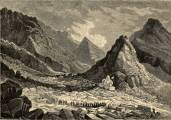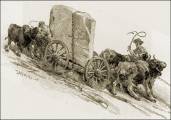


Excerpts From
Construction Materials in
Rooks County, Kansas
Geological Survey Circular 27
By Frank E. Byrne, Henry V. Beck, and Max S. House
Prepared in cooperation with the State Highway Commission
of Kansas.
Department of the Interior for Development, Geological Survey
Washington, D. C., April, 1949
Purpose of the Investigation
The U. S. Geological Survey in the summer of 1946 sent a field party into Rooks County, Kans., to investigate sources of engineering construction materials, as part of a Statewide project conducted in cooperation with the State Highway Commission of Kansas. This report is a part of that inventory and a contribution to the geologic mapping and mineral resource investigations being made in connection with studies of the Missouri River Basin.1
The primary aim of the investigation was to accumulate field and laboratory data pertaining to the geologic materials in Rooks County that would be of use in the construction of dams, irrigation canals, highways, airports, or other engineering structures. Additional geologic data are included in this information useful in the exploitation of the prospects reported or in the location of other sites where materials required to fulfill future engineering needs might be obtained.
-
Figure 1. Index map of Kansas showing areas covered by this report and by other construction materials investigations.

Geography of the Area
Area covered by the investigation: Rooks County is in the border region of the Great Plains physiographic province. Streams cutting headward from the Central Lowlands province to the east have dissected the border region to one of low to moderate relief. The streams occupy steep-sided valleys, many of which are cut more than 150 feet below the gently rounded upland surface. The areas of greatest relief in Rooks County are along the South Fork Solomon River in the central part of the county, along Bow Creek in the northern edge of the county, and along the tributaries to the saline River in the southern part of the county..
Rooks County is served by two railroads. A branch line of the Union Pacific Railroad enters the county at about the center of the western border, swings south through the cities of Damar and Palco, and then runs east across the county. A spur line of the Missouri Pacific Railroad starts at Stockton and runs east to the county line. Stockton, the county seat and largest city in the county, and Woodston also are served by the Missouri Pacific Railroad. With the exception of Webster, the remaining cities in Rooks County are located along the branch line of the Union Pacific.
There is a well-developed system of Federal, State, and county roads. The Federal highways are of the black-top type of construction. U. S. 24, a major east-west transcontinental route, crosses the northern part of the county. U. S. 183, an important north-south highway, extends through the center of the county. The two highways intersect at Stockton. Kansas State Highway 18 nearly parallels the Union Pacific railroad through the southern part of the county. The county and township roads follow or parallel section lines except in the more rugged parts of the county. Only a few of these roads are metaled, but most of them are maintained by grading.
-
Figure 3. Outcropping stratigraphic units in Rooks County, Kansas, and their construction materials.

Inventory of Construction
Materials
(Note: Only the section on "Structural Stone" will be included here.)
Structural Stone
Engineering and Geologic Characteristics: Structural stone, as defined in this report, is any hard, uniform-textured rock material that can be quarried and cut to desired size and form. The sources of such material in Rooks County are somewhat deficient in one respect or another, as indicated in the following descriptions:
Stratigraphic Sources and Performance Characteristics
(1) Fort Hays Limestone Member of the Niobrara Formation: This rock has been used extensively throughout Rooks County as a structural stone for dwellings, farm buildings, and, to a lesser extent, for bridge abutments. The stone hardens after being cut, and structures built of it seem to stand up well in the relatively dry climate of north-central Kansas. Field observations indicate that the Fort Hays limestone should not be used in any place where it is subjected to water saturation unless protected by a cement cover coat, as it deteriorates rapidly when saturated. Additional quarries could be opened at convenient sites in the outcrop area...
(2) Ogallala Formation: Quartzite ledges in the Ogallala formation have been quarried extensively in north-central Kansas for structural stone. Numerous city and county buildings and several bridges constructed of this material were observed. It is the opinion of some engineers that the opal of the quartzite is reactive with a standard cement to the detriment of a structure in which the quartzite is used as a structural stone or as a constituent of concrete aggregate. No field evidence of this type of failure was observed. The stone, however, is so hard that cutting it to required size and shape is difficult.
Occasional use of hard mortar-bed ledges in the Ogallala formation as a source of structural stone for farm buildings, such as barns, was observed in north-central Kansas. This material is not uniformly hard and appears to deteriorate seriously within a few years.
1 Construction Materials in Cloud County, Kansas, 1951, page 1, footnote 1: Missouri River Basin, conservation control, and use of water resources: 78th Cong., 2d sess., S. doc. 191, 1944.
Commercial use of material within this site is strictly prohibited. It is not to be captured, reworked, and placed inside another web site ©. All rights reserved. Peggy B. and George (Pat) Perazzo.